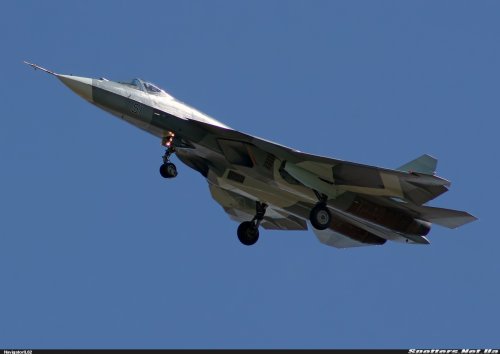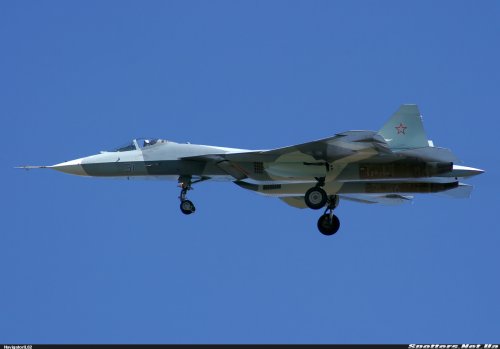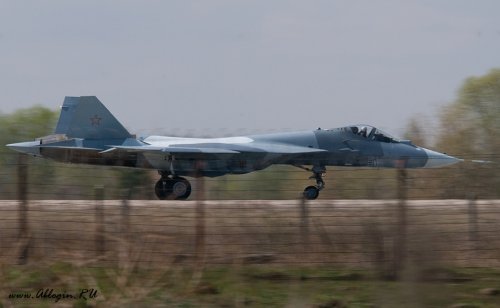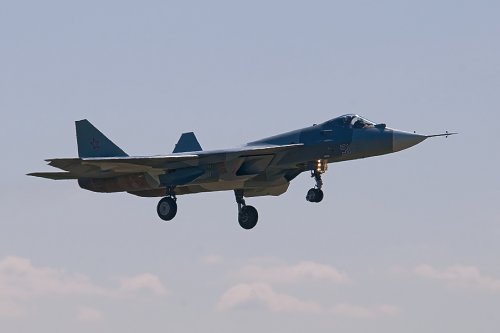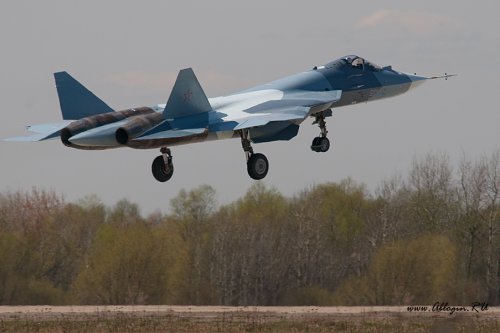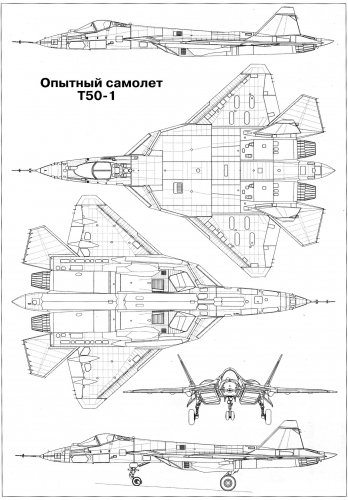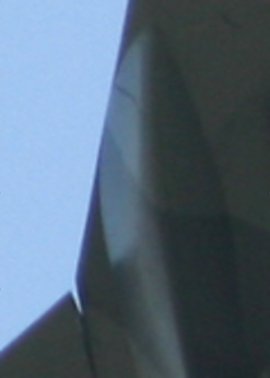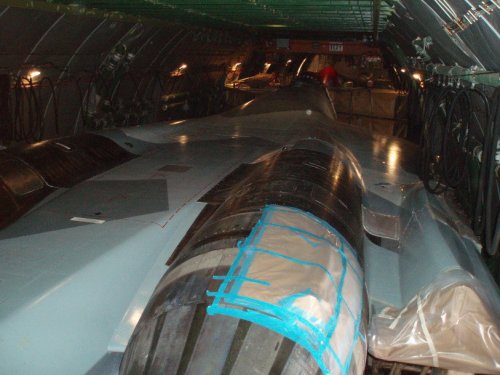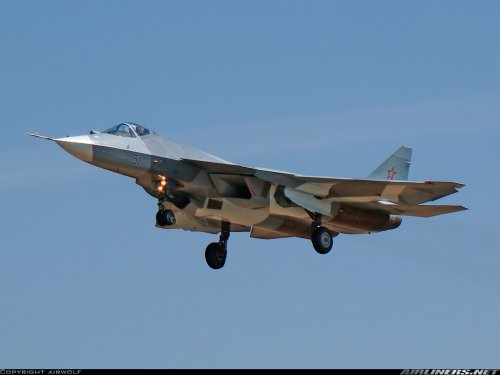You are using an out of date browser. It may not display this or other websites correctly.
You should upgrade or use an alternative browser.
You should upgrade or use an alternative browser.
Sukhoi Su-57 / T-50 / PAK FA - flight testing and development Part I [2010-2012]
- Thread starter Matej
- Start date
- Status
- Not open for further replies.
Probably take-off.ru is suffocated with peeps wanting to see the pics , it shows funny on my comp aswell! ( the russian characters of the text transformed into something ...un-recognizable)
As for the bird...Beautiful ... Better hang on to yer hats , F-22 drivers ... ;D
Thanks to Quadro and all the folks who took these pics and shared them with us ...please keep'em coming!
As for the bird...Beautiful ... Better hang on to yer hats , F-22 drivers ... ;D
Thanks to Quadro and all the folks who took these pics and shared them with us ...please keep'em coming!
Avimimus
ACCESS: Top Secret
- Joined
- 15 December 2007
- Messages
- 2,426
- Reaction score
- 907
donnage99 said:If advance in sensors decreases the effectiveness of stealth for aircraft such as f-22, then how much it decceases the effectiveness of aircraft with less stealth features than the f-22? And how much would it decreases the effectiveness of a non stealthy aircraft? For example, If f-22 can be detected at longer range by more powerful sensors, then how far out can these sensors detect an aircraft with RCS a 100 times or 1000 times larger than f-22?Avimimus said:I've been wondering if the Russian requirements anticipate a future where cheap sensor drones and improvements in technology may decrease the overall effectiveness of stealth. Such a situation would make a strong incentive to prepare for a world where other advantages than LO are required - especially if you can't afford to develop a new fighter more than once every +50 years.
If sensor networks can detect stealth aircraft earlier it reduces the overall value of stealth (as stealth aircraft end up being used more like non-stealthy aircraft). A very stealthy aircraft might still be able to "shoot first", but it might lose the "look first, shoot first" capability which is of such high tactical value. Fifth generation aircraft provide much better situational awareness in BVR and a mixture of performance and tactical awareness can do wonders for a design's ability to get in a good firing position and get out.
Abraham Gubler said:But the theory expressed by Avimimus is total pointless fantasy. They might as well be planning the T-50 for conversion to gravity repulsion drive. I guess if your only intellectual stake in this whole thing is what you like and what you don’t like based on a romantic assessment then making such ridiculous excuses is more than feasible.
Man I wish this forum had a block user function. Would save making the mistake of reading so much nonsense.
It may be possible to infer future developments in this kind of technology from the approach taken by the world's leading engineers and decision makers to development projects. After all, these are the people who will be building future designs regardless of whether those designs are optimal. If the T-50 is optimised for performance over pure stealth than it might indicate that current research may render the overwhelming technological superiority of 1st-3rd generation stealth designs obsolete in the next decade or two as sensors and counter-tactics continue to be developed. Something which seems a very reasonable possibility.
There are two possible motivations for not going the ultra low observable route: the first being that it costs too much and the second being that it isn't expected to remain useful. I'm suggesting that the Russians may be motivated by a combination of these factors. If this is true it would show that current research indicates that the combat environment experienced by 5th generation fighters in the 2030-2050 bracket may be qualitatively different from that experienced in the 1995-2030 bracket. An interesting, if not well supported, possibility.
So this isn't an excuse for the T-50, but rather an attempt at inference regarding current interpretations of future air-combat environments and the doctrines that these interpretations may be producing.
Abraham Gubler: You know, you don't have to read my posts - especially if your comments don't add anything substantive other than pointless speculation about the motivations of my supposedly "pointless speculation".
Something isnt quite right here..Sundog said:Just for ref, the latest AvWeek talks about Pogosyan saying the new engine probably won't show up for ten years, as noted above. Also, it notes that analysts think the thrust of the -117 engines are 30K lbs.
IIRC, didnt Saturn test out the box nozzle configuration as part of the MiG 1.42 program way back in 1995 ?(I recall reading the same in an article in flight international magazine of 1995).
And didnt Sukhoi test out flat nozzles on a modifed Su-27 ? (though Matej says, on a keypub forum posting, that it was meant to be for a larger aircraft -presumably the Sukhoi T-60/T-54 program - and not necessarily for a fifth generation fighter program).
So why does Saturn/Sukhoi need 10 more years and couple of billion $ to produce an industrial strength 2D flat nozzle? Why cant they leverage whatever knowledge they have gained in the past 15 years???
- Joined
- 3 June 2011
- Messages
- 18,335
- Reaction score
- 12,234
sanjeev.k said:Something isnt quite right here..Sundog said:Just for ref, the latest AvWeek talks about Pogosyan saying the new engine probably won't show up for ten years, as noted above. Also, it notes that analysts think the thrust of the -117 engines are 30K lbs.
IIRC, didnt Saturn test out the box nozzle configuration as part of the MiG 1.42 program way back in 1995 ?(I recall reading the same in an article in flight international magazine of 1995).
And didnt Sukhoi test out flat nozzles on a modifed Su-27 ? (though Matej says, on a keypub forum posting, that it was meant to be for a larger aircraft -presumably the Sukhoi T-60/T-54 program - and not necessarily for a fifth generation fighter program).
So why does Saturn/Sukhoi need 10 more years and couple of billion $ to produce an industrial strength 2D flat nozzle? Why cant they leverage whatever knowledge they have gained in the past 15 years???
Maybe they abandoned the flat nozzle for a while. In the case of the F119 I know they went through at least four generations that I can think of so it doesn't surprise me that it'll take some work.
In the previous thread, Abraham Gubler wrote @ Zeus:
You have to be kidding if you think that the simplified marketing material that they show on their webpage would be the same as what capabilities they would actually develop in tandem with the Indian defence establishment. Either ways its hardly definitive.
There are dime a dozen firms around the world doing serious stuff which dont even have bare bones webpages or even marketing materials. Heck, the parts of the indian establishment which end up working on the most critical stuff from re-entry warhead tech to long range AESA's dont even mention those projects and capabilities, and have the most cursory presence on the internet.
On their marketing information for their RCS calculator they have pictures of the F-117 and B-2 with RCS 'hot spots'. They HAVE NOT been able to validate their RCS measurement models for these stealth aircraft against range testing. This is all part of the serious disadvantages someone has in developing a stealth aircraft without 50-70 years of heavy investment behind you.
You have to be kidding if you think that the simplified marketing material that they show on their webpage would be the same as what capabilities they would actually develop in tandem with the Indian defence establishment. Either ways its hardly definitive.
There are dime a dozen firms around the world doing serious stuff which dont even have bare bones webpages or even marketing materials. Heck, the parts of the indian establishment which end up working on the most critical stuff from re-entry warhead tech to long range AESA's dont even mention those projects and capabilities, and have the most cursory presence on the internet.
- Joined
- 3 June 2006
- Messages
- 3,094
- Reaction score
- 3,961
Hey folks,
is the border edge of that roundel "Red Star /Krasnaja Swesda" fully red or in the colours of the Russian flag?
Thanks in advance for a short answer.
is the border edge of that roundel "Red Star /Krasnaja Swesda" fully red or in the colours of the Russian flag?
Thanks in advance for a short answer.
Paralay/Matej - how about giving us your excellent artists impressions of how a PAK-FA with 2D nozzles and a cleaned-up underside would look like (so we dont have to wait 10+ years to see a PAK-FA with flat nozzles!!!).lantinian said:Nice!
2D nozzles will look good on this fighter.
lantinian
ACCESS: Top Secret
- Joined
- 24 March 2007
- Messages
- 539
- Reaction score
- 174
I wonder if large 'M' on top and bottom in T-50 camo scheme means first letter in first name of Mikhail Pogosyan :LOL:
Damm. If you hadn't mentioned it I would never have seen it. Now, this is what I call stealth!
- Joined
- 1 April 2006
- Messages
- 11,390
- Reaction score
- 10,278
saintkatanalegacy
Little Miss Whiffologist
- Joined
- 31 March 2009
- Messages
- 718
- Reaction score
- 17
^makes me think they painted a P on top of the plane 
flying-finn
ACCESS: Confidential
- Joined
- 13 March 2010
- Messages
- 66
- Reaction score
- 20
- Joined
- 27 December 2005
- Messages
- 17,748
- Reaction score
- 26,409
- Joined
- 27 December 2005
- Messages
- 17,748
- Reaction score
- 26,409
Well, its speculative of course, but they appear to be sawtoothed and so far, only things that would open in flight (e.g. main weapons bay doors) seem to be aligned while access panels etc are not.
lantinian
ACCESS: Top Secret
- Joined
- 24 March 2007
- Messages
- 539
- Reaction score
- 174
If these pods in the wing root turn out to be weapon bays that will be one of the things where T-50 puts the F-22 to shame. The Raptor side bays are super space inefficient being designed around an obsolete missile that will likely never be fired in service. I always thought this compatibility with the AIM-9M would be only on paper and secretly hoped for a 2xAIM-9X per bay option operationaly.
I am not sure how does the T-50 sidebays work but the designers did a damm good desicion integrating around a missile with a space saving design.
I now hope LM will do just as good a job integrating the next gen dial range A2A missile as it did with the GBU-39s (SDBs)
I am not sure how does the T-50 sidebays work but the designers did a damm good desicion integrating around a missile with a space saving design.
I now hope LM will do just as good a job integrating the next gen dial range A2A missile as it did with the GBU-39s (SDBs)
- Joined
- 3 June 2011
- Messages
- 18,335
- Reaction score
- 12,234
lantinian said:I always thought this compatibility with the AIM-9M would be only on paper and secretly hoped for a 2xAIM-9X per bay option operationaly.
No reason it still couldn't end up that way.
QuadroFX
Russia, Chelyabinsk
Several more from another photograph here... 
http://www.vesti.ru/doc.html?id=356691
So far all these pics come from the yesterday flight right ? The total must be 7 flights so far... anyway i guess for the ones with the landing gear up we have to hope Sukhoi will release some, it seems the plane didnt flew with the gear up near the airfield ...
http://www.vesti.ru/doc.html?id=356691
So far all these pics come from the yesterday flight right ? The total must be 7 flights so far... anyway i guess for the ones with the landing gear up we have to hope Sukhoi will release some, it seems the plane didnt flew with the gear up near the airfield ...
Jackonicko
ACCESS: Secret
- Joined
- 4 February 2009
- Messages
- 386
- Reaction score
- 907
On April 08, 2010, 03:37:58 pm, on the first page, 'Flanker' asked:
"What is the flight dates so far? have i got this correct?
1 - 29'th January.
2 - 6'th February
3 - 12'th February
4 - 25'th March
5 - 26'th March
6 -"
Any answer?
"What is the flight dates so far? have i got this correct?
1 - 29'th January.
2 - 6'th February
3 - 12'th February
4 - 25'th March
5 - 26'th March
6 -"
Any answer?
lantinian
ACCESS: Top Secret
- Joined
- 24 March 2007
- Messages
- 539
- Reaction score
- 174
It won't. Full 3D vectoring only makes sense when you are replacing all flight controls. 2D nozzles are great for augmenting the flight controls though, like they are used on the F-22.Curious about the 2D flat nozzles; how will it accomplish 3D TVC?
I'm not so sure that they re weapon bays,because there is very narrow space to place a AA missile into it!It seems to me a inefficient place to put a weaponstore beneath the wingroot.lantinian said:If these pods in the wing root turn out to be weapon bays that will be one of the things where T-50 puts the F-22 to shame. The Raptor side bays are super space inefficient being designed around an obsolete missile that will likely never be fired in service. I always thought this compatibility with the AIM-9M would be only on paper and secretly hoped for a 2xAIM-9X per bay option operationaly.
I am not sure how does the T-50 sidebays work but the designers did a damm good desicion integrating around a missile with a space saving design.
I now hope LM will do just as good a job integrating the next gen dial range A2A missile as it did with the GBU-39s (SDBs)
I say it Will house electronics, because the place is a very good one to install the electronics so that there is more room in the main fuselage for other important systems or fuel
lantinian said:It won't. Full 3D vectoring only makes sense when you are replacing all flight controls. 2D nozzles are great for augmenting the flight controls though, like they are used on the F-22.Curious about the 2D flat nozzles; how will it accomplish 3D TVC?
The prevalent assumption is that the PAK-FA will incorporate 3D TVC, indicated by the reduced - albeit all-moving - stabs. A 2D nozzle perhaps doesn't fit too well with this notion.
B. Bolsøy/Oslo
lantinian
ACCESS: Top Secret
- Joined
- 24 March 2007
- Messages
- 539
- Reaction score
- 174
While I agree that many people believe for PAF-FA to have 3D TVC, assuming that will be so because the all-moving canted stabilizers are smaller is just plain wrong. Integrating 3D TVC on the SU-30MIKI did not allow for any reduction of tail size did it? Horizontal or vertical. Other aircraft lack vertical stabilizers altogether and have not TVC of any kind.The prevalent assumption is that the PAK-FA will incorporate 3D TVC, indicated by the reduced - albeit all-moving - stabs.
3D TVC and and tails (vertical or horizontal) are complementary types of control. In some situations the tails can work and the 3D TVC not (engine failure) and in other it could be the opposite (slow speed, high AoA maneuver). Technology is not at a lever where one can replace the other is all flight conditions.
If the Russians had got some lessons learned from the F-22, it is the fighter should be able to go around its whole flight envelope without TVC at all. TVC is only there to speed up the maneuvers.
Any reduction of tails size on the PAK-FA is done because the aircraft can duplicate its function by differential work of the other control services. Think YF-23 air brake and yall (the fighter did not TVC, airbrake and the Tailerons were not effective for yall all by themselves)
As a consequence of this analysis, 3D TVC will only be truly needed in very low speed yall maneuvers. If they are not required operationally, the designer will be better of in investing into lowering the engine IR signature with 2D nozzles. That will have benefits throughout the fighter flight time, not just 1 or 2 maneuvers rarely used maneuvers.
This is not MiG-21. T-50 is an expensive high end fighter. As such, it does not make operational sense to to enter a dog-fight with less expensive aircrafts. So installing 3D TVC just to have an yall edge on the 178 Rators which will be 10-15 away from retirement when T-50 enters service does not make sense either. The T-50 is obviously aimed at the F-35, which it does not need 3D TVC to outmaneuver.
N22YF
ACCESS: Restricted
Well here's how I see things:
I would guess if the Su-30MKI were redesigned with 3D TVC today, they would use smaller tails. It was probably too difficult/expensive to redesign the existing Su-30 airframe when TVC was integrated.
While this is true, how many fighters are of this configuration? This is acceptable for bombers and attack aircraft (B-2, A-12, X-45), but it's not so practical for fighters (X-36, McDonnell Douglas JSF).
No one's going to design a TVC aircraft that loses control with an engine failure. TVC is more of an enhancement, with aerodynamic controls alone still being sufficient. However, this does not mean you cannot reduce or eliminate tails if you're using TVC (again, look at the X-36).
lantinian said:Integrating 3D TVC on the SU-30MIKI did not allow for any reduction of tail size did it? Horizontal or vertical.
I would guess if the Su-30MKI were redesigned with 3D TVC today, they would use smaller tails. It was probably too difficult/expensive to redesign the existing Su-30 airframe when TVC was integrated.
lantinian said:Other aircraft lack vertical stabilizers altogether and have not TVC of any kind.
While this is true, how many fighters are of this configuration? This is acceptable for bombers and attack aircraft (B-2, A-12, X-45), but it's not so practical for fighters (X-36, McDonnell Douglas JSF).
lantinian said:3D TVC and and tails (vertical or horizontal) are complementary types of control. In some situations the tails can work and the 3D TVC not (engine failure) and in other it could be the opposite (slow speed, high AoA maneuver). Technology is not at a lever where one can replace the other is all flight conditions.
If the Russians had got some lessons learned from the F-22, it is the fighter should be able to go around its whole flight envelope without TVC at all. TVC is only there to speed up the maneuvers.
No one's going to design a TVC aircraft that loses control with an engine failure. TVC is more of an enhancement, with aerodynamic controls alone still being sufficient. However, this does not mean you cannot reduce or eliminate tails if you're using TVC (again, look at the X-36).
lantinian
ACCESS: Top Secret
- Joined
- 24 March 2007
- Messages
- 539
- Reaction score
- 174
Very difficult to reduce the size of the vertical tails indeed.It was probably too difficult/expensive to redesign the existing Su-30 airframe when TVC was integrated.
I agree 100% but X-36 is an experimental aircraft, just like the X-29. It is a testbed, not an flying proof that using TVC to replace tails is a practical solution at the moment. Forward swept wings also looked good on paper but never made it mainstream. Suchoi, totally waisted their time and money with this technology. Now they should just rely on the US experience with its 2 trust vector programs and implement the technology in similar fashion.TVC is more of an enhancement, with aerodynamic controls alone still being sufficient. However, this does not mean you cannot reduce or eliminate tails if you're using TVC (again, look at the X-36).
Here is a good article on trust vectoring...
http://www.nasa.gov/centers/dryden/history/pastprojects/Active/pub_online/setp_d6.html
Avimimus
ACCESS: Top Secret
- Joined
- 15 December 2007
- Messages
- 2,426
- Reaction score
- 907
To play the devil's advocated - what if the small vertical stabilisers and the lack of 3d thrust vectoring go hand in hand? Given the horizontal cross-section might it not be possible that the aircraft is hard to control at higher lateral angles of attack? In comparison the larger horizontal leading edge devices could allow for considerable control over moment in high dorsal angle-of-attack manoeuvres. Who knows? The ideal situation for this aircraft might be to use thrust vectoring for roll and pitch but not yaw.
ubiquitous08
ACCESS: Confidential
- Joined
- 11 November 2008
- Messages
- 65
- Reaction score
- 51
Lets look at the purpose of the reduced size vertical tails. Big tails are used for directional stability at high speed (Mig 25) but can be reduced if the airframe has a long fineness ratio (Sr 71) and at high AOA to aid directional stability / roll control. 2D nozzles especially if well offset from the centreline (such as Pakfa) can easily achieve required roll control by differential tvc deflection to say nothing of optimised flight control surface scheduling (such as virtual airbrakes by flap deflection a la F 22, super Hornet etc). Finally 2d nozzles like see the entire aft end faceted which can only be a good thing compared to the rounded aft side sector RCS seen today on the prototype. A case for 3d isn't there if stealth is more impt and additionally deifferential 2D TVC will suffice. The facted transition from the intakes to the rounded mid intake sections coupled with pronouncements of 2 d development heavily imply pakfa was always intended to have 3d and attendant faceting to rear nozzles but it can be assumed the 1st prototypes without availability of engine used this very Su 27 aft engine bay to save time / costs/ show the Indians something concrete.
ubiquitous08
ACCESS: Confidential
- Joined
- 11 November 2008
- Messages
- 65
- Reaction score
- 51
last sentence typo. Substitute 3d for 2d
- Status
- Not open for further replies.
Similar threads
-
Sukhoi Su-57 flight testing, development & operations [2012-current]
- Started by overscan (PaulMM)
- Replies: 4K
-
Sukhoi Su-57 / T-50 / PAK FA first flight - pictures, videos and analysis [2010]
- Started by flateric
- Replies: 872
-
Sukhoi PAK FA news and speculation (T-50, I-21) Part II [2008-2009]
- Started by overscan (PaulMM)
- Replies: 451
-
Sukhoi PAK FA news and speculation (T-50, I-21) Part I [2006-2008]
- Started by overscan (PaulMM)
- Replies: 455
-
Vladimir Sergeevich Ilyushin 31-03-1927 - 01-03-2010
- Started by flateric
- Replies: 4

